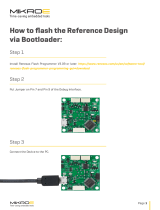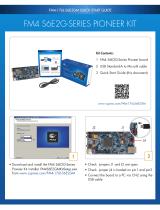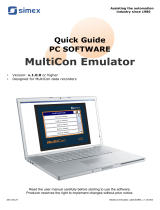Page is loading ...

SHOW TITLE MM/DD/YY
1
FM4-216-ETHERNET
Hardware V1.0 / Documentation V1.3
Document Number: 002-09877 Rev. *A

SHOW TITLE MM/DD/YY
2
Warranty and Disclaimer
© Cypress Semiconductor Corporation, 2014-2017. This document is the property of Cypress Semiconductor Corporation and its subsidiaries, including
Spansion LLC (“Cypress”). This document, including any software or firmware included or referenced in this document (“Software”), is owned by Cypress
under the intellectual property laws and treaties of the United States and other countries worldwide. Cypress reserves all rights under such laws and treaties
and does not, except as specifically stated in this paragraph, grant any license under its patents, copyrights, trademarks, or other intellectual property rights.
If the Software is not accompanied by a license agreement and you do not otherwise have a written agreement with Cypress governing the use of the
Software, then Cypress hereby grants you a personal, non-exclusive, nontransferable license (without the right to sublicense) (1) under its copyright rights in
the Software (a) for Software provided in source code form, to modify and reproduce the Software solely for use with Cypress hardware products, only
internally within your organization, and (b) to distribute the Software in binary code form externally to end users (either directly or indirectly through resellers
and distributors), solely for use on Cypress hardware product units, and (2) under those claims of Cypress’s patents that are infringed by the Software (as
provided by Cypress, unmodified) to make, use, distribute, and import the Software solely for use with Cypress hardware products. Any other use,
reproduction, modification, translation, or compilation of the Software is prohibited.
TO THE EXTENT PERMITTED BY APPLICABLE LAW, CYPRESS MAKES NO WARRANTY OF ANY KIND, EXPRESS OR IMPLIED, WITH REGARD TO
THIS DOCUMENT OR ANY SOFTWARE OR ACCOMPANYING HARDWARE, INCLUDING, BUT NOT LIMITED TO, THE IMPLIED WARRANTIES OF
MERCHANTABILITY AND FITNESS FOR A PARTICULAR PURPOSE. To the extent permitted by applicable law, Cypress reserves the right to make
changes to this document without further notice. Cypress does not assume any liability arising out of the application or use of any product or circuit described
in this document. Any information provided in this document, including any sample design information or programming code, is provided only for reference
purposes. It is the responsibility of the user of this document to properly design, program, and test the functionality and safety of any application made of this
information and any resulting product. Cypress products are not designed, intended, or authorized for use as critical components in systems designed or
intended for the operation of weapons, weapons systems, nuclear installations, life-support devices or systems, other medical devices or systems (including
resuscitation equipment and surgical implants), pollution control or hazardous substances management, or other uses where the failure of the device or
system could cause personal injury, death, or property damage (“Unintended Uses”). A critical component is any component of a device or system whose
failure to perform can be reasonably expected to cause the failure of the device or system, or to affect its safety or effectiveness. Cypress is not liable, in
whole or in part, and you shall and hereby do release Cypress from any claim, damage, or other liability arising from or related to all Unintended Uses of
Cypress products. You shall indemnify and hold Cypress harmless from and against all claims, costs, damages, and other liabilities, including claims for
personal injury or death, arising from or related to any Unintended Uses of Cypress products.
Cypress, the Cypress logo, Spansion, the Spansion logo, and combinations thereof, WICED, PSoC, CapSense, EZ-USB, F-RAM, and Traveo are
trademarks or registered trademarks of Cypress in the United States and other countries. For a more complete list of Cypress trademarks, visit cypress.com.
Other names and brands may be claimed as property of their respective owners.

SHOW TITLE MM/DD/YY
3
Overview
MCU Features, Board Features & Contents
Test it
The Hardware
The Jumper Table / Jumper Default
Board Power
Software Examples & Tools
Flash Programming
JTAG / CMSIS-DAP
IAR-Embedded Workbench
KEIL µVision
Additional documents
Schematics
Data sheet S6E2CC Series
Peripheral Manual
Timer part
Analog part
Communication part
Ethernet part
Flash programming manual

SHOW TITLE MM/DD/YY
4
Features of the S6E2CC Microcontroller
Package:
LQFP144, LQFP176 , BGA192 , LQFP 216,
ARM Cortex-M4 – CPU
200MHz (max)
2.7-5.5V
MPU, FPU
Ta= -40°C to +105°C
Main CLK: 4MHz
SUB CLK: 32kHz
MAIN RC CLK: 4MHz
SUB RC CLK: 100kHz
Subclock (option)
RC oscillator +/-2%
Clock Supervisor
Watch Counter
Low Voltage Detector 2ch
DMA
8ch
External IRQs
32ch + NMI
RTC
Y:M; h:m:s
S6E2CC9H/J/L
S6E2CC8H/J/L
12-bit ADC
ADT x 3ch FRTim x 3ch
OCU x 6ch ICU x 4ch
Waveform
Generator
Multi Function Timer
3ch
Dual Timer
12-bit ADC
12-bit ADC
QDU 4ch
S6E2CCAH/J/L
USB FS Host+Function 2ch
CAN (32 MSB) 2ch
CRC
Base Timer
16ch
Ethernet MAC 10/100MBit
PPG 9ch
SRAM
128K
FLASH
1MB
SRAM
192K
FLASH
1.5MB
SRAM
256K
FLASH
2MB
SWJ/TPIU/ETM Debug Ports
Resource
Pin Relocation
Quad SPI
CAN-FD 1ch
32ch
12-bit DAC
2ch
MFS(UART/SPI/I
2
C) 16ch
External Bus Interface
(SRAM, SDRAM, NAND, ..)
DSTC 256ch
Hardware Watchdog
I2S
SD Card I/F

SHOW TITLE MM/DD/YY
5
Features of the board
Features of the FM4-216-ETHERNET board:
• Microcontroller Cypress FM4 S6E2CCAL0A
• FM connect Ethernet: 1x IEEE802.3 Ethernet
• FM connect CAN: 2x CAN transceiver + 1x CAN-FD transceiver
• FM connect USB: 2x USB-Host (Type-A connector), 1x USB-Device (Type-B connector)
• FM touch: Slider using four ADC channels
• FM inverter: Motor-Control-Interface for e.g. POWER-3P-LV2-MC
• FM color: Cypress S/W TFT interface
• Cypress flash memory S25FL164K, connected via quad SPI interface
• I²S audio interface
• SD Card interface
• 1x USB-to-serial converter (Type-B connector) using Cypress FM3 MB9AF312K
UART and on-board JTAG simultaneously (CMSIS DAP)
• Additional JTAG and Trace Interfaces each on a 20 pin-header
• 2x Cypress Multicon flexible serial interface supporting I²C, SPI, UART, and LIN
• User interface
Backlit LCD module
5x pushbuttons (User buttons), potentiometer
1x Reset-button, Reset-LED
• All 216 pins routed to pin-header
• On-board 5V and 3V voltage regulators to supply MCU with separate Power-LEDs
• 4x Power supply options: USB, USB-Device, JTAG or external 9V to 24V

SHOW TITLE MM/DD/YY
6
Contents FM4-216-ETHERNET
The FM4-216-ETHERNET box contains
• The FM4-216-ETHERNET evaluation board
• USB cable
• Ethernet cable
• CD: Documentation, software examples and development utilities
• 1-page flyer
ESD foam ESD box FM4-216-ETHERNET USB, Ethernet cable
CD ROM Additional information
A
B
RJ45
RJ45

SHOW TITLE MM/DD/YY
7
Test it
The microcontroller on the FM4-216-ETHERNET
is already preprogrammed with an example application (<drive:>\Examples\fm4-216-ethernet-tp_v12.srec).
Verify that jumpers JP75 and JP77 are set to 1-2 position and jumper JP76 is set to 3-4 position
Connect the FM4-216-ETHERNET via DEBUG USB port (X2) with the PC
Verify that switch S1 is set to RUN
Press the Reset-button
The FM4-216-ETHERNET‘s display will show a greeting message
Using the Up and Down pushbuttons will scroll through a menu on the LCD module
Connect X3 (static IP address 192.168.1.20) to a PC or local area network
Configure your PC to an untaken IP address within the same subnet (such as 192.168.1.42)
Point your webbrowser to board‘s IP address (192.168.1.20)
Install the USB Driver first <drive:>\drivers\driverinstaller.exe
Check the availibility for virtual COM port e.g. with Windows Device Manager
Open a serial terminal tool
e.g. Cypress Serial Port Viewer
<drive:>\tools\serialportviewer\setup.exe
Settings 115200 baud, 8N1
More board tests are available via serial console

SHOW TITLE MM/DD/YY
8
Test it
You finished successfully the first tests
Now you will get more details about the
FM4-216-ETHERNET
You will learn more about
• The on-board features
• How to program the Flash
• How to start with IAR-Embedded-Workbench and KEIL µVision

SHOW TITLE MM/DD/YY
9
Hardware

SHOW TITLE MM/DD/YY
10
The Hardware (Top Side) – Function Overview
Vin: 9..24V
DEBUG
CAN2 (FD)
CAN1
USB Host
0/1
USB
Device
Ethernet
S6E2CCAL0A
Flash
Run/Prog
switch S1
Trace
JTAG
Reset
button
MultiCon 0/1
Variable
Resistor
Power
switch S2
CAN0
2x16 LCD Module
Five user buttons
FM touch
Audio Interface
MB9AF312K
Motion Control I/F
SD Card I/F
TFT Interface

SHOW TITLE MM/DD/YY
11
Jumper Settings – Power the starterkit
The starter kit can be powered by
• External power supply (9-24V)
Set jumpers JP75 and JP77 to position 1-2
Caution: Always set JP75 and JP77 horizontally, never vertically!
Connect X1 to 8..24V DC power
Switch S2 into ON position
• USB
There are three ways to power the starter kit via USB
Set jumpers JP75 and JP77 to position 2-3
Set jumper JP76 according to the desired power source:
• For CAN2 (CAN FD), external power supply must be used, not USB
ON
JP76
Power source
Connector
1-2
USB Device
X12
3-4
DEBUG
X2
5-6
JTAG (ensure that adapter can provide enough current for
your application! Some JTAG probes source insufficient
power and some features might misbehave unexpectedly)
J14

SHOW TITLE MM/DD/YY
12
The Hardware – Connectors
J6
X2
X1
J1
J5
J4
J2
J8
J7
J11
J9
J10
J12
J13
J14
J3
J15
J17
J18
J16
J20 J19
X4 X7 X10
X11
X12 X3
X9 X8 X6 X5
X13

SHOW TITLE MM/DD/YY
13
Connectors
Connectors FM4-216-ETHERNET
Number
Description
J1
MCU pins 163..216
J2
MCU pins 1..54
J3
VCCin (1: before switch, 2: after switch)
J4
MCU pins 55..108
J5
MCU pins 109..162
J6
4x GND
J7
2x 5V
J8
2x 3V3
J9
Multicon 0
[J10]
Multicon 0 optional
J11
Multicon 1
[J12]
Multicon 1 optional
J13
Trace
J14
JTAG
J15
Motor drive interface
J16
Motor I/F: Optional signals
J17
Hall Sensors
J18
QPRC
[J19]
Display RGB888 connector
[J20]
FPC/FCC connector
Number
Description
X1
DCin 9..24V
X2
Debug
X3
Ethernet
X4
CAN0
X5
Audio line out
X6
Audio headphones out
X7
CAN1
X8
Audio microphone in
X9
Audio line in
X10
CAN2 (CAN FD)
X11
USB Host (0/1)
X12
USB Device
X13
SD Card Connector

SHOW TITLE MM/DD/YY
14
Jumper Settings – (Top Side)
: default position
JP4
JP8
JP9
JP18
JP22
JP10
JP44
JP79, 80
JP73
JP26 JP28
JP40 JP42
JP21
JP70
JP71
JP56
Solder
Jumper
Regular
Jumper
JP13
JP62
JP76
JP75
JP77
JP5

SHOW TITLE MM/DD/YY
15
Jumper Settings – (Bottom Side)
JP45, 46, 50-53, 59
JP72
JP1
JP3
JP16, 17
JP14, 15
JP54, 55, 60, 61
JP36-39
JP43
JP63-69 JP29-32
JP2
JP11, 12 JP6, 7
JP78
JP81
JP74
JP19, 20
JP23, 24, 27 JP34, 35, 41
JP33
JP49
JP47 JP48
JP57, 58
JP25
Solder
Jumper

SHOW TITLE MM/DD/YY
16
Jumper
Jumper Settings FM4-216-ETHERNET
Number
Description
Special Type
Default
JP1
USBVCC0
Solder Jumper
Closed
JP2
USBVCC1
Solder Jumper
Closed
JP3
ETHVCC
Solder Jumper
Closed
JP4
MCUVCC
Closed
JP5
USB/UART programming
Closed
JP6
X0A Access
Solder Jumper
Closed
JP7
X1A Access
Solder Jumper
Closed
JP8
AVRH
Closed
JP9
AVCC
Closed
JP10
AVRL
Closed
JP11
X0 Access
Solder Jumper
Open
JP12
X1 Access
Solder Jumper
Open
JP13
VBAT
Closed
JP14
Multicon0: SCL pull-up
Solder Jumper
Open
JP15
Multicon0: SDA pull-up
Solder Jumper
Open
JP16
Multicon1: SCL pull-up
Solder Jumper
Open
JP17
Multicon1: SDA pull-up
Solder Jumper
Open
JP18
DBG Prog (S/W upgrade U2)
Open
Number
Description
Special Type
Default
JP19
MFS0_SOT
Solder Jumper
Closed
JP20
MFS0_SIN
Solder Jumper
Closed
JP21
EthPHY IRQ
Solder Jumper
Closed
JP22
Supply VCCin from motor
Open
JP23
CAN0GND4
Solder Jumper
Open
JP24
CAN0GND6
Solder Jumper
Open
JP25
CAN0pwr
Solder Jumper
Open
JP26
CAN0RX
Solder Jumper
Closed
JP27
CAN0term
Solder Jumper
Open
JP28
CAN0TX
Solder Jumper
Closed
JP29
LCDRST
Solder Jumper
Closed
JP30
HMISCL
Solder Jumper
Closed
JP31
HMISDA
Solder Jumper
Closed
JP32
LCDBL
Solder Jumper
Closed
JP33
CAN1pwr
Solder Jumper
Open
JP34
CAN1GND4
Solder Jumper
Open
JP35
CAN1GND6
Solder Jumper
Open
JP36
I2SDO
Solder Jumper
Closed

SHOW TITLE MM/DD/YY
17
Jumper
Jumper Settings FM4-216-ETHERNET
Number
Description
Special Type
Default
JP37
I2SDI
Solder Jumper
Closed
JP38
I2SCK
Solder Jumper
Closed
JP39
I2SWS
Solder Jumper
Closed
JP40
CAN1RX
Solder Jumper
Closed
JP41
CAN1term
Solder Jumper
Open
JP42
CAN1TX
Solder Jumper
Closed
JP43
I2SMCLK
Solder Jumper
Closed
JP44
I2SAGND
Solder Jumper
Closed
JP45
CAN2RX
Solder Jumper
Closed
JP46
CAN2TX
Solder Jumper
Closed
JP47
CAN2pwr
Solder Jumper
Open
JP48
CAN2GND4
Solder Jumper
Open
JP49
CAN2GND6
Solder Jumper
Open
JP50
CAN2S
Solder Jumper
Closed
JP51
CAN2C
Solder Jumper
Closed
JP52
CAN2O
Solder Jumper
Closed
JP53
CAN2I
Solder Jumper
Closed
JP54
Touch AN24
Solder Jumper
Closed
Number
Description
Special Type
Default
JP55
Touch AN25
Solder Jumper
Closed
JP56
CANFDBAT
Solder Jumper
Closed
JP57
CAN2termH
Solder Jumper
Open
JP58
CAN2termL
Solder Jumper
Open
JP59
CAN2Wake
Solder Jumper
Closed
JP60
Touch AN26
Solder Jumper
Closed
JP61
Touch AN27
Solder Jumper
Closed
JP62
POWERON
Closed
JP63
Button UP
Solder Jumper
Closed
JP64
Button RIGHT
Solder Jumper
Closed
JP65
Button CENTER
Solder Jumper
Closed
JP66
Button LEFT
Solder Jumper
Closed
JP67
Button DOWN
Solder Jumper
Closed
JP68
Button IRQ
Solder Jumper
Closed
JP69
RP1
Solder Jumper
Closed
JP70
EthPHY XO
Solder Jumper
Closed
JP71
EthPHY XI
Solder Jumper
Closed
JP72
Ethernet Yellow LED
Solder Jumper
Closed

SHOW TITLE MM/DD/YY
18
Jumper
Jumper Settings FM4-216-ETHERNET
Number
Description
Special Type
Default
JP73
I2S48.1k
Solder Jumper
Closed
JP74
USB HCONX
Solder Jumper
Closed
JP75
1-2: External power supply
2-3: Supply via USB or JTAG
JP75 must
equal 77
1-2
JP76
1-2: USB Device (X11)
3-4: Debug port (X2)
5-6: JTAG (J11) (watch voltage!)
Only relevant
if JP75 and
JP77 set to 2-3
3-4
JP77
1-2: External power supply
2-3: Supply via USB or JTAG
JP75 must
equal 77
1-2
JP78
SD_CD:
1-2: CD
2-3: CD/DAT3
Solder Jumper
1-2
[JP79]
Backlight enable
Open
[JP80]
Backlight dimming
Open
[JP81]
LCD power control
1-2

SHOW TITLE MM/DD/YY
19
Hardware
Pin-List FM4-216-ETHERNET (3/9)
Pin
Function
Description
1
VCC
MCUVCC
2
PA0/RTO20_0/TIOA8_0/AIN2_0/INT00_0/MADATA00_0
Pushbutton UP
3
PA1/RTO21_0/TIOA9_0/BIN2_0/MADATA01_0
Pushbutton RIGHT
4
PA2/RTO22_0/TIOA10_0/ZIN2_0/MADATA02_0
Pushbutton CENTER
5
PA3/RTO23_0/TIOA11_0/MADATA03_0
Pushbutton LEFT
6
PA4/RTO24_0/TIOA12_0/MADATA04_0
Pushbutton DOWN
7
PA5/SIN1_0/RTO25_0/TIOA13_0/INT01_0/MADATA05_0
Pushbutton IRQ
8
PA6/SOT1_0/DTTI2X_0/MADATA06_0
9
PA7/SCK1_0/IC20_0/MADATA07_0
10
P50/SCS72_0/RTO00_1/TIOA8_2/MADATA16_0
Motor0/MFT0
11
P51/SCS73_0/RTO01_1/TIOB8_2/MADATA17_0
Motor0/MFT0
12
P52/RTO02_1/TIOA9_2/MADATA18_0
Motor0/MFT0
13
P53/RTO03_1/TIOB9_2/MADATA19_0
Motor0/MFT0
14
PA8/SIN7_0/IC21_0/INT02_0/WKUP1/MADATA08_0
Ethernet PHY IRQ
15
PA9/SOT7_0/IC22_0/MADATA09_0
16
PAA/SCK7_0/IC23_0/MADATA10_0
USB (Host1 VBUS enable)
17
PAB/SCS70_0/RX0_0/FRCK2_0/INT03_0/MADATA11_0
USB1 Overcurrent IRQ
18
PAC/SCS71_0/TX0_0/TIOB8_0/AIN3_0/MADATA12_0
Motor0/QPRC3
19
P54/SIN15_1/RTO04_1/TIOA10_2/INT00_2/MADATA20_0
Motor0/MFT0
20
P55/SOT15_1/RTO05_1/TIOB10_2/MADATA21_0
Motor0/MFT0
21
P56/SCK15_1/DTTI0X_1/TIOB0_1/MADATA22_0
Motor0/MFT0
22
P57/IC00_1/TIOB1_1/MADATA23_0
Motor0/IC0
23
PAD/SCK3_0/TIOB9_0/BIN3_0/MADATA13_0
Motor0/QPRC3
24
PAE/ADTG_0/SOT3_0/TIOB10_0/ZIN3_0/MADATA14_0
Motor0/QPRC3

SHOW TITLE MM/DD/YY
20
Hardware
Pin-List FM4-216-ETHERNET (3/9)
Pin
Function
Description
25
PAF/SIN3_0/TIOB11_0/INT16_0/MADATA15_0
26
P58/SIN11_1/IC01_1/TIOB2_1/INT02_2/MADATA24_0
Motor0/IC0
27
P59/SOT11_1/IC02_1/TIOB3_1/MADATA25_0
Motor0/IC0
28
P5A/SCK11_1/IC03_1/TIOB4_1/MADATA26_0
29
P5B/FRCK0_1/TIOB5_1/MADATA27_0
30
P08/SIN14_0/TIOB12_0/INT17_0/MDQM0_0
31
P09/SOT14_0/TIOB13_0/INT18_0/MDQM1_0
32
P0A/ADTG_1/SCK14_0/AIN2_1/MCLKOUT_0
33
P5C/TIOA11_2/MADATA28_0/RTCCO_1/SUBOUT_1
Motor0 OPT1 (Brake)
34
P30/RX0_1/TIOA13_2/INT03_2/MDQM2_0/I2SDI_0
I2S serial receive data input pin
35
P31/TX0_1/TIOB13_2/MDQM3_0/I2SCK_0
I2S bit clock terminal
36
P32/BIN2_1/INT19_0/S_DATA1_0
SD I/F
37
P33/FRCK0_0/ZIN2_1/S_DATA0_0
SD I/F
38
P34/IC03_0/INT00_1/S_CLK_0
SD I/F
39
VCC
MCUVCC
40
VSS
GND
41
P35/IC02_0/INT01_1/S_CMD_0
SD I/F
42
P36/IC01_0/INT02_1/S_DATA3_0
SD I/F
43
P37/IC00_0/INT03_1/S_DATA2_0
SD I/F
44
P38/ADTG_2/DTTI0X_0/S_WP_0
SD I/F
45
P39/SIN2_1/RTO00_0/TIOA0_1/AIN3_1/INT16_1/S_CD_0/MAD24_0
SD I/F
46
P3A/SOT2_1/RTO01_0/TIOA1_1/BIN3_1/INT17_1/MAD23_0
47
P3B/SCK2_1/RTO02_0/TIOA2_1/ZIN3_1/INT18_1/MAD22_0/MNALE_0
48
P3C/SIN13_0/RTO03_0/TIOA3_1/INT19_1/MAD21_0/MNCLE_0
/




